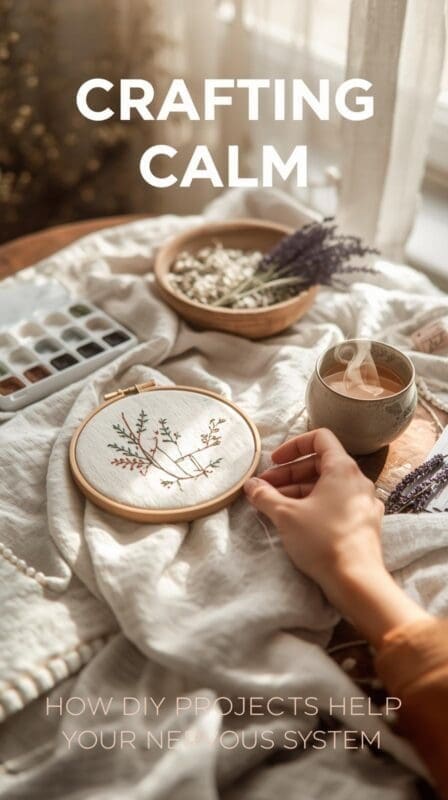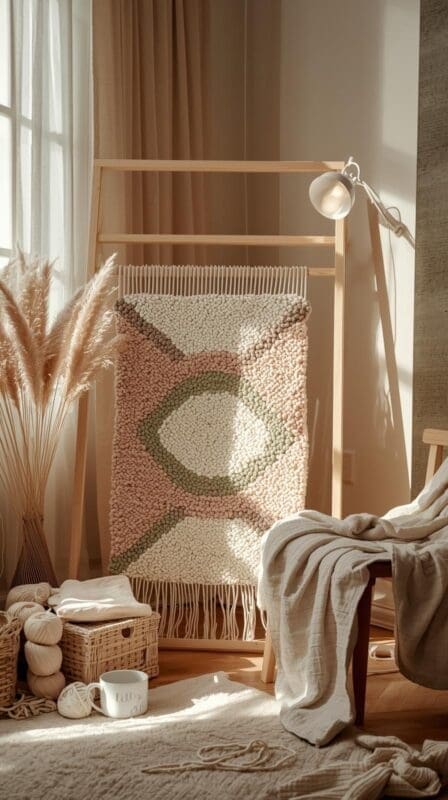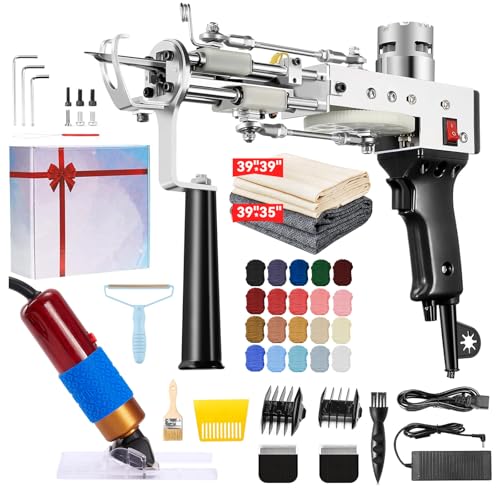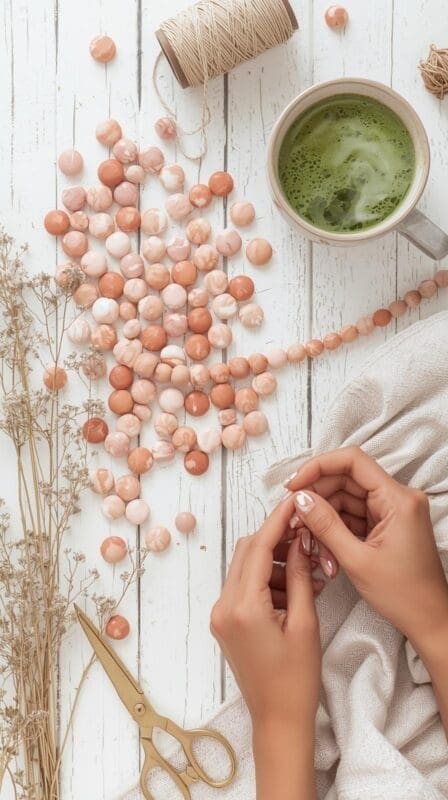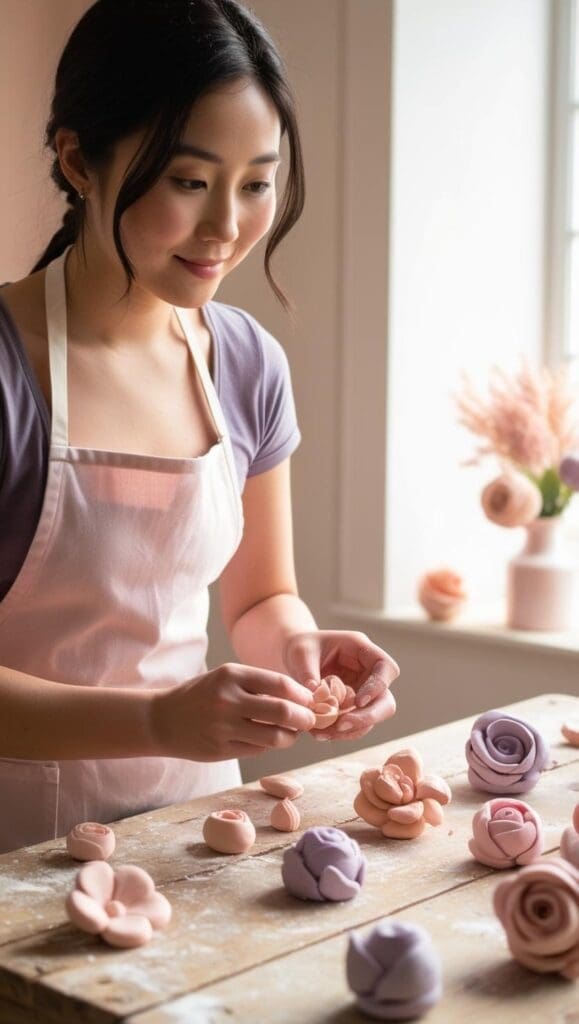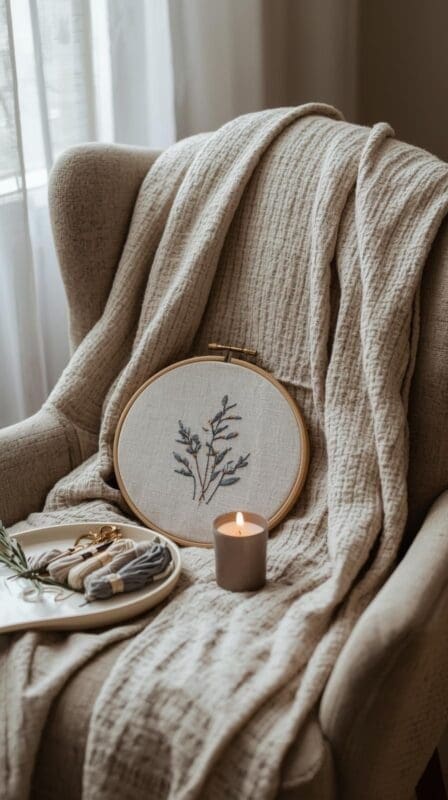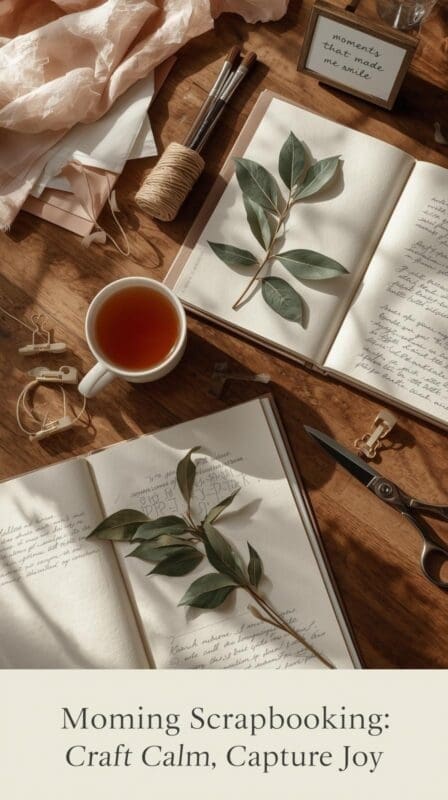It’s important to disclose that this blog post contains affiliate links. This means that if you make a purchase through these links, we may earn a commission at no additional cost to you.
You dim the lamp, silence your phone, and clear a small corner of the table. Yarn brushes your wrist like a whisper; a warm mug breathes quiet steam beside you. Your shoulders drop a notch as your fingers press into soft fibers, roll a bead of clay, or guide a needle along a simple line. There’s no audience, no deadline—only rhythm. The day’s static fades. Breath slows. Your nervous system shifts from rush to rest.
This isn’t “just” a hobby. For many of us—therapists, teachers, parents, creatives—crafting has become a modern, science-backed antidote to burnout. The textures, the repetition, the little wins, the tiny choices of color and pattern—all of it nudges the body toward safety and the mind toward focus.
In this guide, you’ll learn how five trending crafts—tufting, clay beading, candle-making, embroidery/punch needle, and mindful scrapbooking—do more than look pretty. We’ll pair aesthetic inspiration with therapeutic rationale, then give you simple steps (plus affiliate-friendly gear ideas you can link later) to start your own calming craft ritual.
The Psychology of Crafting: Why It Works
Crafting calms because it’s mindfulness with movement. When your hands engage with materials, your attention anchors in the present. That’s not woo—it’s nervous-system literacy.
- Dopamine & Motivation: Small, achievable steps—threading a needle, finishing a row, pouring wax—create micro-rewards. Each “I did it” moment releases dopamine, reinforcing focus and motivation.
- Vagus-Nerve Soothing: Slow breathing and rhythmic motion (stitching, rolling clay, tufting strokes) stimulate the parasympathetic branch, helping the body down-shift from fight/flight to rest & digest.
- Bilateral Stimulation: Many crafts use both hands in alternating patterns (think knitting, weaving, punching). This left-right movement can feel regulating (similar in spirit to how EMDR uses bilateral input).
- Flow State: Repetitive, moderately challenging tasks are ideal for flow—that satisfying “in the zone” feeling where rumination quiets and time softens.
- Behavioral Activation: In therapy, we use this concept to help mood by getting people gently moving toward meaningful actions. Crafts are built-in structured pleasure—low stakes, real satisfaction.
Counselor lens: The goal isn’t perfection; it’s physiological safety. Materials, motion, and tiny wins tell the nervous system, You’re safe. You can focus. You can breathe.
Craft Trends That Soothe the Mind & Body
1) Tufting — Plush Texture, Deep Grounding
Picture This
Warm light glows across a monk’s cloth frame. The tufting gun hums—a soft, steady buzz—as loops bloom into plush texture. Your hands guide color in slow arcs, like drawing in velvet.
Why It Helps
Tufting engages proprioception (your body’s sense of pressure and position). That gentle push of the gun into fabric plus the visual softness of looped yarn can feel as grounding as a mini weighted blanket. Repetitive passes foster rhythm and focus, dialing down mental noise.
Try This (Beginner-Friendly)
- Stretch monk’s cloth tightly over a tufting frame.
- Thread yarn and practice short lines to learn pressure and speed.
- Fill in a simple block pattern (two or three colors).
- Brush, trim, and secure the back with carpet glue; add rug backing when dry.
Therapist Tip: Pair your strokes with breath pacing—inhale as you guide the line, exhale as you pause and check edges.
New to tufting? This is a starter tufting gun, frame, and monk’s cloth “like this” to make setup easy.
How to Make a Simple Tufted Rug
What You’ll Need:
- A tufting gun
- Yarn (in your favorite colors)
- A tufting frame and monk’s cloth
- Carpet glue and backing fabric
Steps:
- Stretch monk’s cloth over your tufting frame.
- Load your tufting gun with yarn and start creating your design by pressing the gun against the cloth.
- Continue tufting until your design is complete.
- Apply carpet glue to the back and let it dry.
- Attach backing fabric for a finished look.
2) Clay Beading — Tactile Focus, Quiet Hands
Picture This
Cool clay rolls beneath your palms, smoothing as you warm it. You press, swirl two colors into a soft marble, and pierce a perfect channel with a skewer. Beads line up like tiny moons.
Why It Helps
Polymer clay offers tactile regulation. The cool, pliable texture can reduce anxiety while the repetitive rolling/piercing sequence creates a meditative rhythm. Fine-motor focus supports calm, sustained attention.
Try This (Beginner-Friendly)
- Condition clay until soft.
- Roll into small balls or tube shapes; marble two tones for visual pleasure.
- Pierce with a skewer; bake per package directions.
- String onto elastic or wire; knot and secure.
Therapist Tip: Notice sensation words while you work—cool, smooth, firm, soft—to anchor presence and interoception.
A polymer clay kit with tools simplifies your first set.
- DIY gift for children and artists: 50-color polymer clay starter kits, easy to shape, arbitrary fabrication, rich colors…
- Packaging and weight: two-layer plastic storage box set, 50 pieces of polymer clay, single clay PE bag packaging, creati…
- Material: It is made of soft polymer clay, free of wheat, nuts or peanuts. It strictly abides by ASTM D-4236 standards a…
How to Make Clay Beads for Jewelry
What You’ll Need:
- Polymer clay
- Rolling pin
- Toothpick or skewer
- Baking tray and oven
- String or wire for jewelry
Steps:
- Knead the clay until it’s soft and pliable.
- Roll it into small balls or shape it into different bead designs.
- Use a toothpick to poke a hole through each bead.
- Bake the beads according to the clay package instructions.
- Once cooled, string them into necklaces or bracelets.
3. Candle-Making: Engaging Scent & Light for Relaxation
Picture This
Wax melts in a small pitcher, turning ivory liquid. You stir slowly, tip in a little vanilla or lavender, then pour into a glass jar. Later, the first flicker is golden and kind.
Why It Helps
Candle-making engages olfactory (scent) and visual systems—two powerful pathways to memory and mood. Mild aromas can cue safety; warm flame (or LED candlelight) supports relaxation and evening wind-down. The clear sequence—melt, scent, pour, cool—creates a soothing sense of completion.
Try This (Beginner-Friendly)
- Melt soy wax in a double boiler.
- Stir in a gentle fragrance oil (low %; or unscented for sensitivity).
- Fix wick in a jar; pour wax; let cool fully.
- Trim wick; label with blend and date.
Therapist Tip: Choose one scent only for your “calm association” candle. Light it only during self-care to teach your body a reliable cue.
A soy wax starter set keeps it simple.
- 【THE PERFECT SET FOR BEGINNERS】LED display wax melting pot 500 ml x 1, soy wax x 6, beeswax x 2, aromatherapy x 8, dye b…
- 【WAX MELTING POT】Upgraded professional wax melter for candle making, especially suitable for adult beginners. You no lon…
- 【NATURAL SOY WAX FOR CANDLE MAKING】Specially developed 100% natural granulated soy candle wax & beeswax with more stabil…
How to Make a Simple Scented Candle
What You’ll Need:
- Soy wax flakes
- Candle wicks
- Fragrance oils
- A glass jar or tin
- Double boiler
Steps:
- Melt soy wax in a double boiler until fully liquid.
- Add a few drops of fragrance oil and stir.
- Place a wick in the center of a glass jar or tin.
- Carefully pour the melted wax into the jar.
- Let it cool and harden before trimming the wick and using it.
4) Embroidery or Punch Needle — Rhythm & Flow
Picture This
Fabric is drum-tight in the hoop. Needle in, needle out—tiny sounds like rain on canvas. Color creeps across linen in quiet arcs; a small pattern grows, stitch by stitch.
Why It Helps
Repetition invites flow. Slow bilateral work plus visual progress reduces rumination and supports vagus-nerve calm. Punch needle offers plush loops and soft resistance (great for tactile seekers); embroidery rewards precision and presence.
Try This (Beginner-Friendly)
- Hoop fabric; sketch a simple motif (leaf, moon, stripe).
- Thread needle (or punch tool) and follow the outline.
- Fill areas with backstitch/satin stitch (embroidery) or loops (punch).
- Steam or press; hang as a tiny win you can see.
Therapist Tip: Let imperfections stay. Say aloud, “This is evidence of being human,” to practice gentleness.
Try a punch-needle set if you prefer plush texture.
- High-Quality Materials & Abundant Accessories: This punch needle kit is beautifully packaged in a gift unique-designed b…
- Suitable for Beginners and Professionals: This DIY kit is perfect for kids or adults, offering both detailed instruction…
- Perfect for Home Decor: Sugar bloom assortment featuring six vibrant patterns, this kit allows you to create versatile c…
How to Get Started with Embroidery
What You’ll Need:
- Embroidery hoop
- Fabric
- Embroidery floss
- Needle
- Pattern or design
Steps:
- Place fabric into an embroidery hoop.
- Thread your needle with embroidery floss.
- Follow a simple pattern, using stitches like backstitch or satin stitch.
- Work slowly and focus on the rhythmic movement of stitching.
5) Mindful Scrapbooking & Journaling — Meaning by Hand
Picture This
A blank page, soft tape, a little stack of printed photos. You cluster three textures—paper, ribbon, a pressed leaf—then add a caption: What softened me this week?
Why It Helps
Scrapbooking blends visual storytelling with small decisions. Choosing images, arranging layers, and writing a line or two externalizes emotion and reduces mental clutter. It’s reflective without being heavy—form meets feeling.
Try This (Beginner-Friendly)
- Choose a theme: gratitude, tiny joys, winter calm.
- Layer 2–3 papers, add a photo or sticker.
- Write one sentence: a memory, a hope, a thank-you.
- Seal with tape, breathe out, turn the page.
Therapist Tip: End each layout with one sensory note—I remember the sound/scent/light—to deepen embodied recall.
A starter scrapbook will carry you far.
- The retro scrapbook paper supplies kit includes 348 sheets. Scrapbooking supplies kit contains:1 A6 grid notebook with v…
- 256 Page A6 grid notebook can carry all your idea, plans, daily, experience. The size of scrapbooking notebook is 5.8″ x…
- This scrapbook supplies comes with assorted vintage paper in various designs, their classic prints include plants, flowe…
How to Create a Mindfulness Scrapbook
What You’ll Need:
- A blank scrapbook or journal
- Printed photos, magazine cutouts, or stickers
- Markers, pens, or watercolor paints
- Glue or double-sided tape
Steps:
- Choose a theme, such as gratitude, dreams, or affirmations.
- Cut and arrange images or stickers that reflect your theme.
- Write captions, thoughts, or quotes alongside your images.
- Decorate with colors and textures that bring you joy.
Picture This: Crafting as Self-Care
Imagine coming home after a long day. Instead of doom-scrolling on your phone, you settle into a cozy corner with your tufting frame. The rhythmic buzz of the tufting gun and the softness of the yarn ground you in the present moment. With each tuft, your breathing slows, and the tension in your shoulders eases.
Or maybe it’s a Sunday afternoon, and you’re rolling clay between your fingers, shaping beads into tiny marbled masterpieces. The cool, pliable texture is comforting, and as you string the beads into a bracelet, you feel a deep sense of satisfaction.
Crafting as Nervous System Regulation
| Craft | System Engaged | Regulation Type | Good For |
|---|---|---|---|
| Tufting | Proprioceptive + tactile | Grounding via pressure & rhythm | Restlessness, overthinking |
| Clay Beads | Fine motor + tactile | Focused calm, present-moment attention | Anxiety, fidget needs |
| Candle-Making | Olfactory + visual | Soothing association, evening down-shift | Stress, sleep rituals |
| Embroidery/Punch | Bilateral + cognitive | Flow, mindful pacing, breath syncing | Rumination, perfectionism |
| Scrapbooking | Visual + emotional | Expression, meaning-making, memory | Low mood, mental clutter |
Reflection: Each craft is a doorway back to safety. Ask, What does my body need right now—movement, texture, scent, or story? Then choose accordingly.
Crafting as a Mindful Ritual
Rituals teach the body what to expect. Create a tiny ceremony:
- Set the scene: Warm lamp, gentle playlist, one tidy tray of tools.
- Transition phrase: “When I sit here, I leave the noise outside.”
- Pace with breath: Inhale on prep, exhale on the first stitch/roll/pour.
- Close with reflection: One line in a notebook—Before crafting I felt… After I feel…
Over time, this becomes your nervous-system shortcut—a reliable path from “I’m wired” to “I’m here.”
Therapeutic Crafting Tips (Save This)
- Keep sensory-safe options: latex-free gloves, unscented wax, soft yarns.
- Choose colors that match your goal: soothing neutrals for calm, soft blues/greens for focus.
- Take micro-pauses; clenching = time to stretch and sip water.
- Celebrate imperfections. Each uneven stitch is a proof of presence.
- Start small (20–30 minutes). Consistency beats intensity.
Crafting as Group Connection
Making side-by-side builds social safety. Mirror neurons help us sync; shared rhythm reduces pressure to “perform” verbally.
- Host a candle-night with two scents (or a scent-free option) and tea.
- Start a counselor craft club—30 minutes of making after supervision.
- Try parent-child bead sessions: kids roll beads; adults string. Conversation flows more easily when hands are busy.
Therapist insight: “If you can laugh and make, you can think again.” Co-regulation through creativity is gentle medicine.
How to Integrate Crafting Into Self-Care
- Start small: Choose one craft and one tray of tools.
- Schedule it: A weekly 30-minute appointment with yourself.
- Stack habits: Light your “calm” candle, then craft.
- Track feelings: Before/after body check—jaw, shoulders, breath.
- Rotate wisely: Pick the craft that matches your nervous-system need that day.
FAQs
Do I need to be artistic to benefit?
No. Regulation comes from process, not perfection. Simple shapes, straight lines, and repetitive motions are ideal.
Which crafts are best for anxiety vs. low mood?
For anxiety, try clay beads (tactile + repetitive) or embroidery (slow pacing). For low mood, scrapbooking (meaning-making) or tufting (big sensory payoff) can help.
What if I get frustrated?
Pause and reset. Switch tools, soften the goal (one row, one bead), or change crafts. Frustration is a cue to reduce complexity.
Can crafting replace therapy?
No. It’s a powerful adjunct—a tool for regulation and reflection. If you’re struggling, seek support from a licensed professional.
How do I set up a tiny space?
Use a portable caddy or tray. Keep one lamp, one tool set, and a small materials box. Clear surface = easier start.
What about scent sensitivities?
Use unscented wax or candles and avoid strong essential oils. Choose visual anchors (warm light) over olfactory cues.
Gentle Conclusion
Crafting is a small rebellion against a world that measures us by output. It’s a way to remember that your hands are not only for productivity—they’re for teaching your mind to rest. Texture, rhythm, and color become a language of safety your nervous system understands.
Choose one craft. Prepare one tray. Light one lamp. Breathe. The project will grow slowly; calm often does, too.
What to read next:
- Winter Crafts for Adults: Mindful Art Projects for Stress Relief
- DIY Christmas Gifts That Calm
- Therapy Crafts for Kids: Emotional Regulation Tools

About the Author
Hi, I’m Eve, a former school counselor with a master’s degree in School Psychology and a passionate advocate for children and families navigating sensory challenges. As a mom of children with sensory sensitivities, I deeply understand the journey special-needs parents face, and I dedicate myself to researching and sharing practical solutions to help children thrive and feel comfortable in their bodies. My goal is also to empower counselors, therapists, and psychologists with creative strategies and supportive resources to enrich their everyday practice. When I’m not writing or exploring new therapeutic approaches, you’ll find me spending quality time with my family and continually seeking inspiration from everyday moments.

